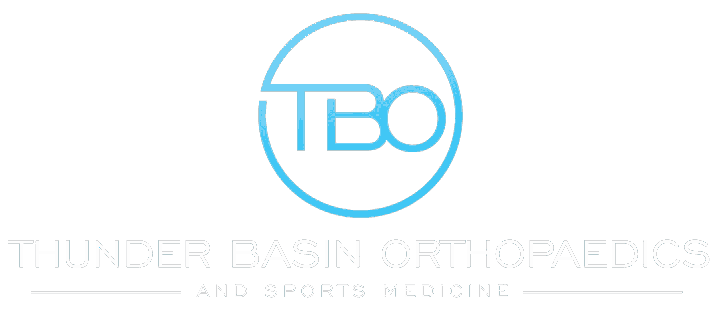At Thunder Basin Orthopaedics, we understand the passion and commitment that athletes of all levels bring to their chosen sports. As a caregiver brand, our mission is to provide nurturing, protection, and compassionate care to our patients, ensuring they can get back in the game as soon as possible. In this blog post, we’ll explore common sports injuries, from sprains to fractures, and discuss their treatments and how our expert team can help you recover and return to your favorite activities.
Contents
Sprains
A sprain is an injury to a ligament, the fibrous tissue that connects bones to one another. Sprains typically occur when a joint is twisted or overstretched, resulting in a partial or complete tear of the ligament. They are most common in the ankle, wrist, and knee.
Symptoms of a sprain include pain, swelling, bruising, and reduced range of motion in the affected joint. To diagnose a sprain, our medical professionals may perform a physical examination and may use imaging tests such as X-rays or MRIs if necessary.
Treatment for sprains depends on the severity of the injury. For minor sprains, the RICE (rest, ice, compression, and elevation) method is often effective in reducing pain and swelling. More severe sprains may require immobilization with a brace or cast, and in some cases, surgery may be necessary to repair the damaged ligament. Physical therapy may also be recommended to help restore strength and mobility to the affected joint.
Strains
A strain is an injury to a muscle or tendon, the fibrous tissue that connects muscles to bones. Strains often occur when a muscle is overstretched or overexerted, causing the fibers to tear. They are most common in the hamstring, quadriceps, and calf muscles.
Symptoms of a strain are similar to those of a sprain, with pain, swelling, and reduced range of motion being the most common. Our medical professionals will perform a physical examination and may use imaging tests to confirm the diagnosis.
Treatment for strains is similar to that for sprains, with the RICE method being the first line of defense. In more severe cases, physical therapy may be necessary to help regain strength and flexibility, and surgery may be required in extreme cases.
Fractures
A fracture is a break in a bone, which can range from a hairline crack to a complete break. Fractures can occur from direct impact, repetitive stress, or as a result of an underlying medical condition that weakens the bones.
Symptoms of a fracture include intense pain, swelling, bruising, deformity, and an inability to bear weight on the affected limb. Our medical professionals will perform a physical examination and use imaging tests, such as X-rays or CT scans, to diagnose the fracture.
Treatment for fractures depends on the type and severity of the break. Some fractures can be treated with a cast or brace to immobilize the bone, while others may require surgery to realign the bone fragments and stabilize the injury with screws, plates, or rods. In addition, physical therapy is often recommended to help regain strength, mobility, and function in the affected area.
Dislocations
A dislocation occurs when the bones in a joint are forced out of their normal positions, usually as a result of direct impact or extreme force. Dislocations are most common in the shoulder, elbow, and knee.
Symptoms of a dislocation include severe pain, swelling, bruising, and visible deformity. Our medical professionals will perform a physical examination and use imaging tests to diagnose the dislocation.
Treatment for dislocations typically involves reducing the joint, which means gently manipulating the bones back into their proper positions. This procedure is often performed under local anesthesia or sedation. Once the joint is reduced, immobilization with a sling or brace may be necessary, followed by physical therapy to restore strength and range of motion.
Prevention Tips
Preventing sports injuries is crucial to maintaining a healthy and active lifestyle. Here are some practical tips to help reduce the risk of injuries:
- Warm-up and cool-down: Begin each exercise session with a proper warm-up and cool-down to prepare your muscles and joints for activity and reduce the risk of injury.
- Use appropriate gear: Wear protective gear specific to your sport, such as helmets, mouth guards, and padding. Also, ensure that your footwear is appropriate for the activity and provides adequate support.
- Maintain proper conditioning: Regularly engage in strength training, flexibility exercises, and cardiovascular workouts to keep your body in top condition.
- Practice proper technique: Learn and consistently use the correct techniques for your sport to reduce the risk of injury.
- Don’t push through pain: If you experience pain during activity, stop and seek medical attention if necessary. Continuing to participate in sports when you’re in pain can worsen injuries and prolong recovery time.
At Thunder Basin Orthopaedics, our compassionate and professional team is committed to helping athletes and individuals of all ages recover from sports-related injuries, ensuring they can return to the activities they love. If you’re experiencing pain or discomfort from a sprain, strain, fracture, or dislocation, don’t hesitate to reach out to us. Early intervention and expert care can make a significant difference in your recovery. Contact us today to schedule an appointment, and let our dedicated team of orthopaedic specialists guide you on the path to healing and renewed strength.


